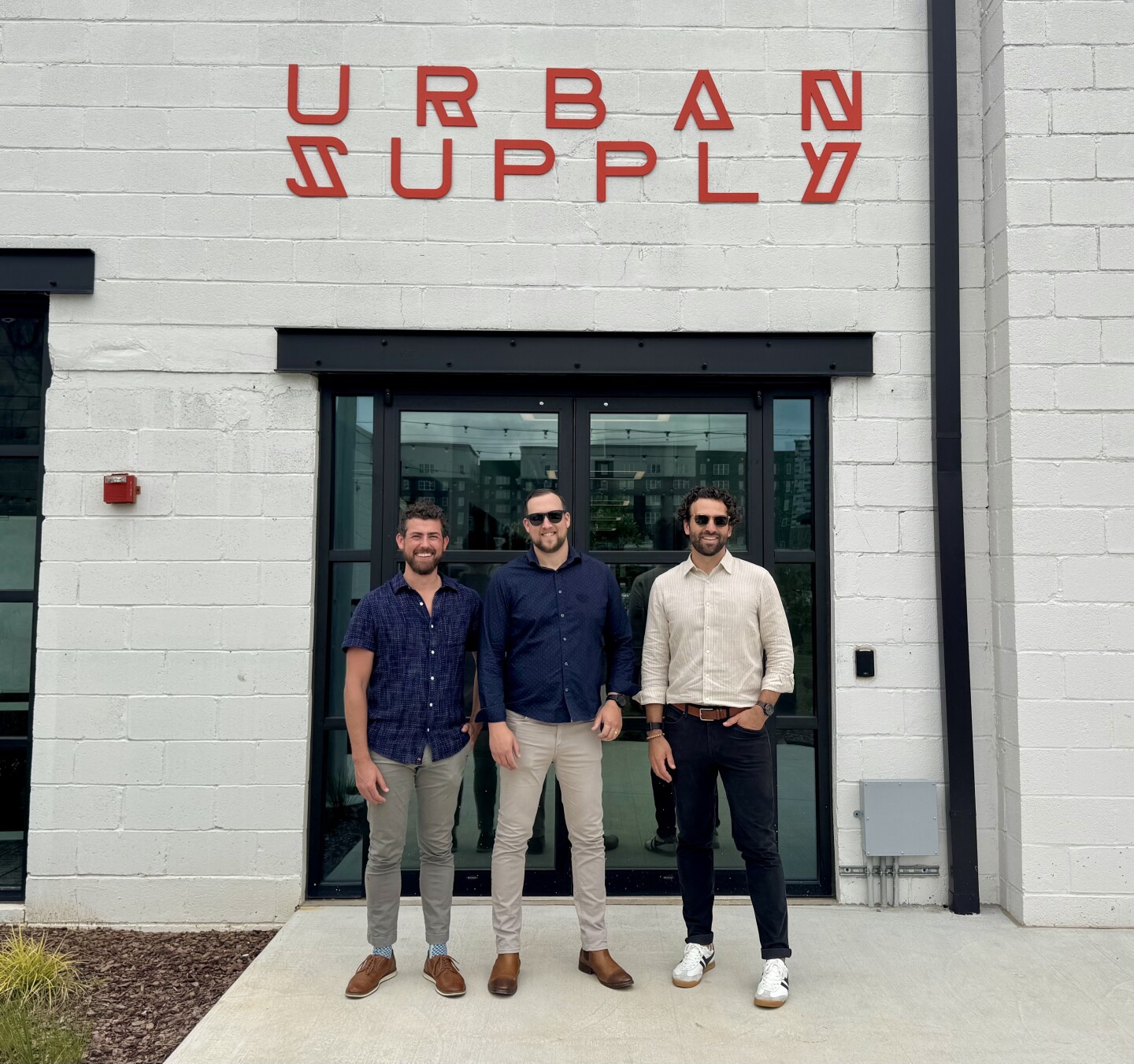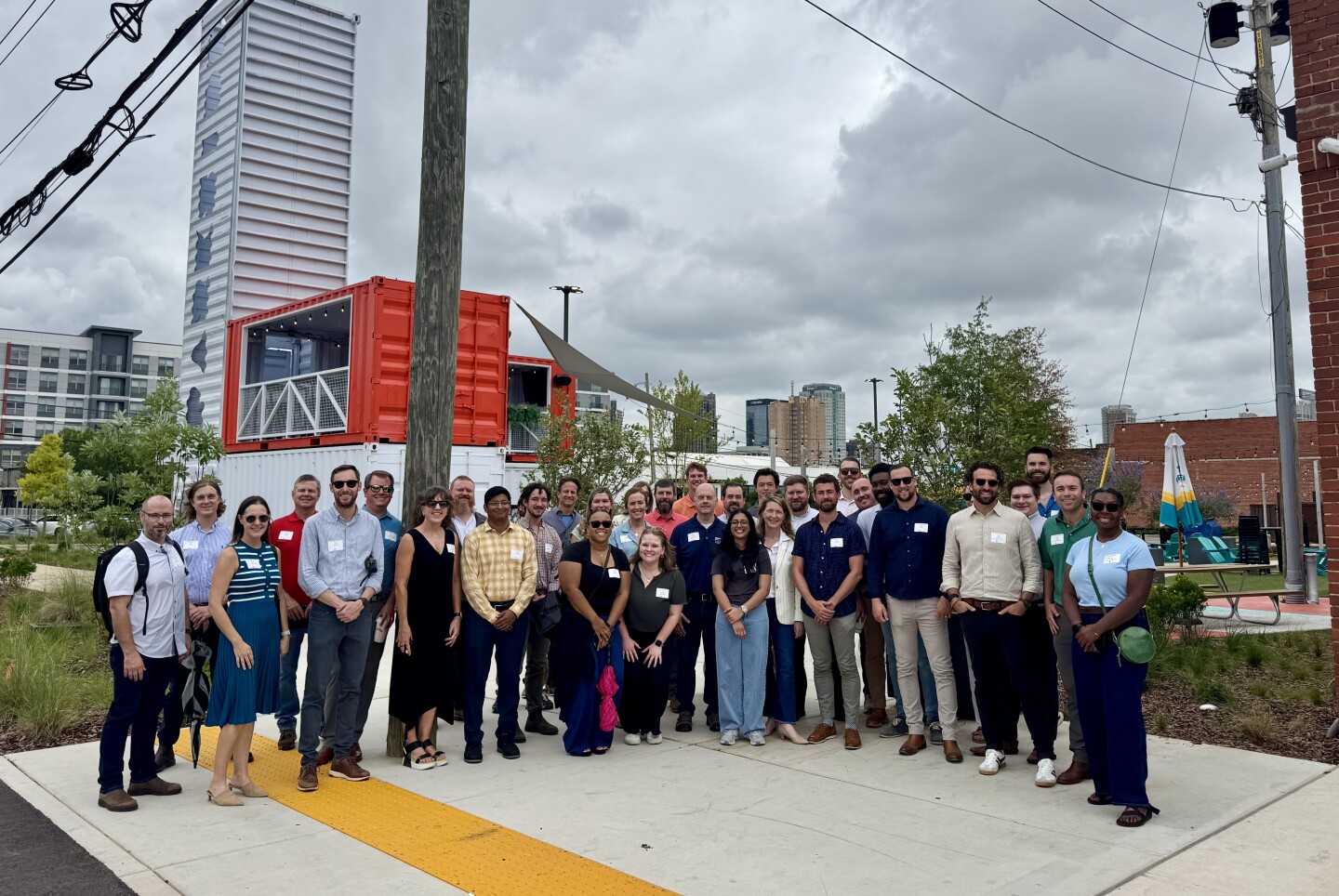Standing in the shadow of Regions Field and within earshot of Railroad Park, Birmingham’s Urban Supply hints at what the next chapter of downtown life could look like in this northern Alabama city. Once-quiet brick warehouses are being steadily reimagined into patios, storefronts, and gathering spaces along a new pedestrian alley. Early tenants have begun to open their doors, and programming is slowly bringing people into the district. Although the project is still in its early stages, the framework is in place for a vibrant hub that will grow block by block in the years ahead.
For Hunter Renfroe, CEO and co-founder of Birmingham-based developer Orchestra Partners, the changes began with a simple observation. “In 2017, my partner and I sat outside Good People Brewing and started talking about how Birmingham needed more places like this—active, outdoor gathering spots that felt social, connected, and welcoming,” Renfroe recalls. Looking down an alley between warehouses, they imagined what became The Aisle, the spine of Urban Supply.
Today, that vision has matured into a $36.4 million development spanning more than 73,000 square feet (6,800 sq m) across six historic properties. Positioned as the western bookend of the Parkside District’s revitalization, Urban Supply extends westward the Rotary Trail, a four-block linear park built on a former rail line, and begins to bridge downtown with Titusville, one of Birmingham’s historic African American neighborhoods, located just outside the city center.
The evolution of downtown
Urban Supply is not an isolated venture but instead part of a decade-long transformation of downtown Birmingham. “Downtown Birmingham has been quietly redefining itself over the past decade plus,” notes Craig Hey, vice chair of Cushman & Wakefield’s Sunbelt multifamily advisory group. Since 2010, more than $2.5 billion in investment has flowed into the city’s core, catalyzed by marquee projects such as Railroad Park and Regions Field.
Railroad Park provided Birmingham with its first true central park, whereas Regions Field brought professional baseball back downtown in 2013. Together, those anchors now draw more than 350,000 annual visitors. They have also helped to attract nearly 2,000 new residential units within walking distance.
With downtown’s residential populace surpassing 10,000, the foundation was set for the next wave of development focused on mixed-use, walkable, and authentic places. In that spirit, Urban Supply was designed to knit together entertainment, office, and retail to serve the surrounding high-density apartments.

Hunter Renfroe of Orchestra Partners, Matt Phillips of Plot Studio, and Clark Bailey of Kimley-Horn. The team behind the vision, design and execution of this urban renewal project and several other broader plans for revitalizing the City of Birmingham. This is signage facing inwards toward The Aisle, the main pedestrian walkway connecting all of the Urban Supply buildings.
Urban Supply
Permeability
Renfroe describes the project’s guiding design principle in one word: permeability. “What we were drawn to,” he explains, “was the ability for people to move through blocks, stumble on hidden courtyards, and discover intimate outdoor spaces. That insight, more than anything, became the backbone of Urban Supply.”
The layout reflects that philosophy. Rather than creating a single monumental structure, Orchestra Partners reimagined two blocks of existing warehouses as interconnected passages, patios, and storefronts. The Aisle serves as a central pedestrian walkway lined with retail and dining. Side courtyards open into spillover spaces, allowing people to drift from a coworking space to a cocktail patio to a container bar without ever crossing a street.
This human-scale network of connections was inspired, in part, by the 2004 Birmingham City Center Master Plan, which envisioned an open space framework of walkable greenways linking neighborhoods. Renfroe sees Urban Supply as one stop along that corridor of activity, stitched together by the Rotary Trail, Railroad Park, and the Red Rock Trail System, a planned 750-mile (1,200 km) countywide network of trails that already links several Birmingham neighborhoods.
The bones of Urban Supply are its historic warehouses, preserved and adapted rather than razed. For Renfroe, this approach is both practical and philosophical. “Historic buildings are a city’s memory,” he says. “They were built in an era when cities were designed for people first, not cars. Adaptive reuse allows us to keep that character intact while reimagining spaces for today’s needs. To me, it’s the most sustainable form of development.”
Alabama’s generous state historic tax credit program was instrumental in making the numbers work by covering 25 percent of rehabilitation costs, with federal tax credits layering on another 20 percent. Those incentives, combined with patient off-market acquisitions and careful negotiations, gave Orchestra Partners the runway to piece together the multiblock site. The financing structure, blending seed funding, private debt, and layered tax credits, also reflected Orchestra’s belief in gradual, lower-risk urban revitalization that grows in tandem with the surrounding neighborhood.
Pandemic pressure
Urban Supply’s timeline collided head-on with the pandemic. “We were halfway through closing on the land acquisitions when Covid hit,” Renfroe says. “We were too far along to stop but not far enough along to just blow through it.” With preleasing underway, tenants suddenly evaporated. The development team had to improvise, leaning into outdoor activations and creative site programming to maintain momentum.
Lyndsy Yim, principal of Skyline Management Services and a key partner in leasing, remembers the grind. “I’ll never forget what tenant recruitment looked like during the pandemic,” she says. “I camped out at Urban Supply with back-to-back tours, masks on, and even overlapped a few minutes so prospects could sense high demand. I canvassed Atlanta heavily, DMing operators, and even offered to pick them up and drive them to Birmingham for a tour.”
Those efforts paid off. By spring 2025, UpDown Arcade Bar opened its newest location: a two-story container bar on The Aisle and an adjacent arcade in the interior of an old brick-and-beam warehouse. As of late summer 2025, the project was more than 75 percent leased.

A behind-the-scenes tour of Urban Supply for the ULI Alabama chapter that took place on June 5, 2025. Attendees heard from Clark Bailey of Kimley-Horn, Hunter Renfroe of Orchestra Partners, and Matt Phillips of Plot Studio on the vision, challenges, and transformation that brought this project to life.
Urban Supply
Urban Supply’s merchandising strategy reflects lessons from the pandemic: prioritize outdoor connectivity, community engagement, and experiential retail. The roster mixes local Birmingham operators with new-to-market concepts. Fairway Social, a golf-themed entertainment venue from Atlanta, chose Urban Supply for its first location outside Georgia. Thrive, an Atlanta-based coworking brand, also expanded here.
For Yim, the goal was to position Urban Supply as the “living room of the Parkside District,” a place where locals and visitors alike can linger, discover, and return. That balance of authenticity and novelty has helped attract a steady stream of tenants, despite the headwinds.
If Railroad Park and Regions Field were catalytic investments, Urban Supply represents the connectivity that transforms Parkside from a set of destinations into a true neighborhood. The Parkside District, bounded by 13th and 20th streets south of the rail lines, was once dominated by warehouses and industry. Today, it has emerged as Birmingham’s most visible mixed-use corridor.
“Parkside has become Birmingham’s proving ground for urban living,” Renfroe says. “Urban Supply adds a pedestrian-scale experience that complements the big civic anchors. It’s about filling in the seams, transforming old warehouses into places where people work, gather, and play.”
Hey agrees, pointing out that the district has now reached a critical mass. “With thousands of new apartments already built and largely stabilized, downtown Birmingham now has stronger density to help support street-level retail,” he says. That density, paired with connectivity to the University of Alabama at Birmingham and its 24,000 employees, positions Parkside as a model for Southern urban revitalization.
Lessons for other cities
Birmingham’s success is drawing notice. Cities such as Memphis, Montgomery, and Jackson—smaller Southern metros with similar industrial bones—are watching closely. The lesson, Hey argues, is that catalytic urban redevelopment doesn’t require billion-dollar stadiums or megaprojects. Instead, the formula is a mix of uses, a strong residential base, and leadership committed to placemaking.
Urban Supply embodies that formula: historic preservation plus modern amenities, local character plus regional tenants, and patient capital plus entrepreneurial energy. It shows that incremental, human-scaled projects can have citywide impact, and that adaptive reuse is often more durable than new construction because it carries authenticity baked into its very walls.
For Orchestra Partners, Urban Supply is both culmination and springboard. “We’ve completed construction and are now in the final stretch of leasing the last spaces,” Renfroe says. “The next phase is about layering in more character, partnering with artists, collaborating with local operators, programming public spaces with food trucks and events.”
Looking ahead, the firm also has its eye on nearby anchors, including the Powell Steam Plant, a decommissioned industrial facility on the east end of Parkside that is being repositioned for mixed-use development. Together, Urban Supply and the steam plant represent the bookends of a district that could eventually link seamlessly into Titusville and other west-side neighborhoods.
Longer term, Orchestra Partners is pivoting toward partnerships with property owners rather than traditional ownership, thus aiming to scale placemaking impact across Birmingham and beyond it. “Cities are full of historic buildings that deserve thoughtful reinvention,” Renfroe notes. “Helping stewards turn them into authentic, people-centered places is the kind of work I want to keep doing.”








